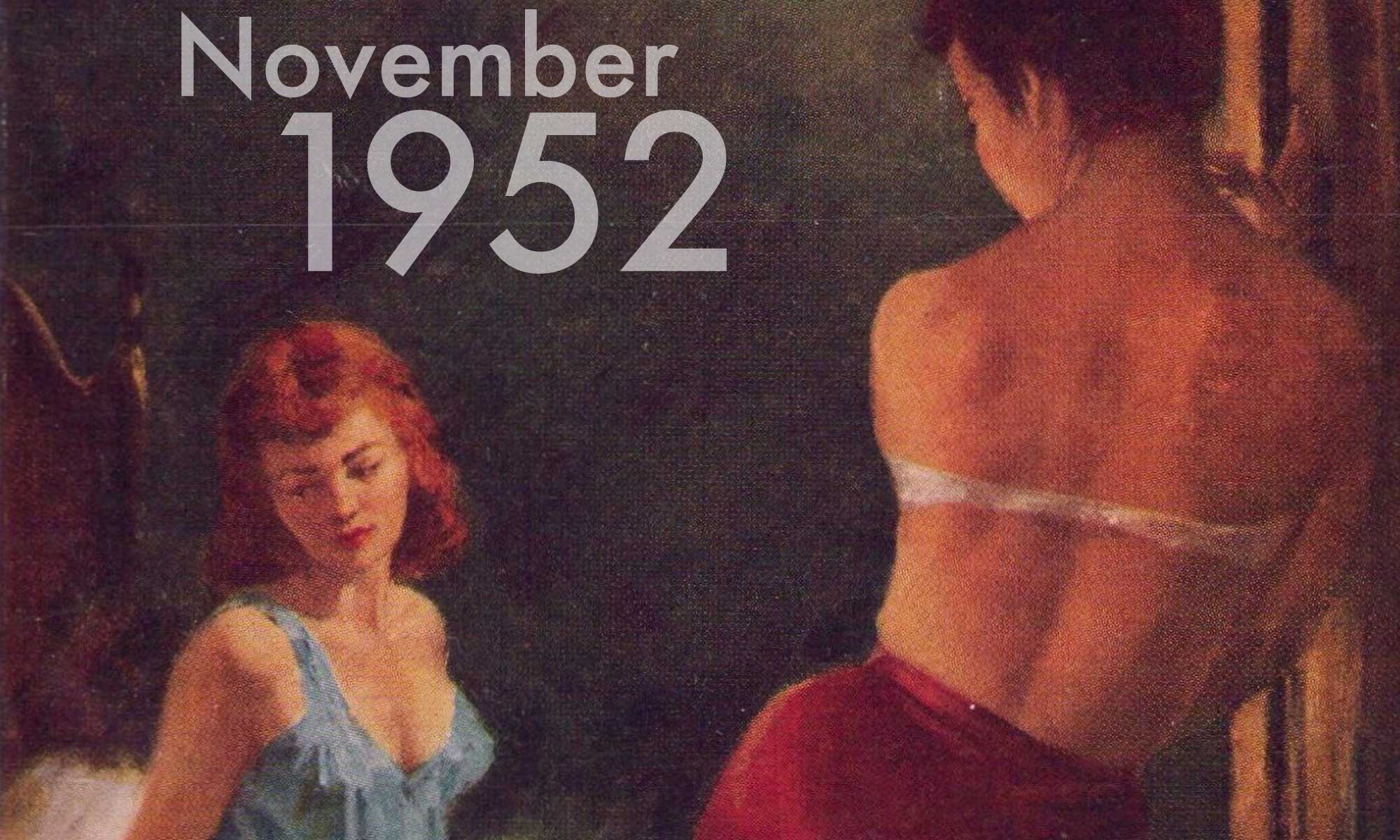| ◄ NOVEMBER ► | ||||||
|---|---|---|---|---|---|---|
| ◄ 1952 ► | ||||||
| 1 | ||||||
| 2 | 3 | 4 | 5 | 6 | 7 | 8 |
| 9 | 10 | 11 | 12 | 13 | 14 | 15 |
| 16 | 17 | 18 | 19 | 20 | 21 | 22 |
| 23 | 24 | 25 | 26 | 27 | 28 | 29 |
| 30 | ||||||
| President: | Harry S Truman (D) | |||
| Vice-President: | Alben W. Barkley (D) | |||
| House: | 230 (D) | 200 (R) | 1 (Other) | 4 (Vacant) |
| Southern states: | 103 (D) | 2 (R) | ||
| Senate: | 49 (D) | 47 (R) | ||
| Southern states: | 22 (D) | |||
| GDP growth: | 6.2% | (Annual) | ||
| 1.9% | (Quarterly) | |||
| Inflation: | 1.1% | |||
| Unemployment: | 2.8% | |||
| US killed in action, | 447 | (This month) | ||
| Korean conflict: | 32,656 | (Since Jun 28, 1950) | ||
![]()
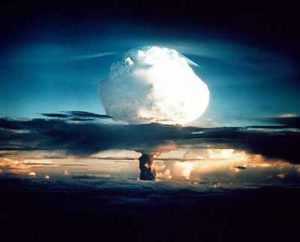 Nov 1: The United States detonates the world’s first thermonuclear bomb on Elugelab Island, a part of the Eniwetok Atoll in the Marshall Islands. The blast yields 10.4 megatons, almost 500 times the yield of the bomb dropped on Nagasaki. Eight megatons of the yield was from fast fission of the uranium tamper, creating massive amounts of radioactive fallout. The hydrogen bomb obliterates the island. The bomb used deuterium as its fusion fuel, which is maintained as a liquid by an expensive and cumbersome cryogenic system. While the design is weaponized, it will be quickly abandoned when a solid fuel design is proven. The detonation and its results will be kept secret for several weeks.
Nov 1: The United States detonates the world’s first thermonuclear bomb on Elugelab Island, a part of the Eniwetok Atoll in the Marshall Islands. The blast yields 10.4 megatons, almost 500 times the yield of the bomb dropped on Nagasaki. Eight megatons of the yield was from fast fission of the uranium tamper, creating massive amounts of radioactive fallout. The hydrogen bomb obliterates the island. The bomb used deuterium as its fusion fuel, which is maintained as a liquid by an expensive and cumbersome cryogenic system. While the design is weaponized, it will be quickly abandoned when a solid fuel design is proven. The detonation and its results will be kept secret for several weeks.
![]()
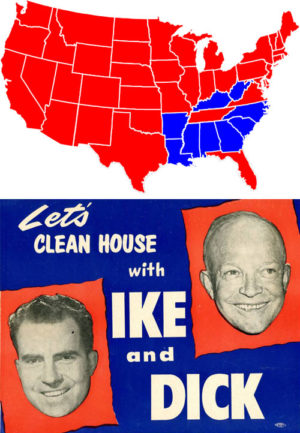 Nov 4: Republican Gen. Dwight D. Eisenhower wins a landslide victory over Democratic Illinois Gov. Adlai Stevenson to become the President of the United States. The Republican victory ends a twenty-year streak of Democratic wins. Republicans attacked the unpopular President Truman for his handling of the Korean War and the cold war, and claim that Soviet spies have infiltrated the U.S. government, especially the state department. Stevenson tried to separate himself from the unpopular Truman, but Truman’s high-profile whistlestop campaign on Stevenson’s behalf did little to help. Eisenhower and his running mate, California Sen. Richard Nixon, capture 55.2% of the popular vote and 442 electoral votes, against Stephenson’s and Alabama Sen. John Sparkman’s 44.3% of the popular vote and 89 electoral votes.
Nov 4: Republican Gen. Dwight D. Eisenhower wins a landslide victory over Democratic Illinois Gov. Adlai Stevenson to become the President of the United States. The Republican victory ends a twenty-year streak of Democratic wins. Republicans attacked the unpopular President Truman for his handling of the Korean War and the cold war, and claim that Soviet spies have infiltrated the U.S. government, especially the state department. Stevenson tried to separate himself from the unpopular Truman, but Truman’s high-profile whistlestop campaign on Stevenson’s behalf did little to help. Eisenhower and his running mate, California Sen. Richard Nixon, capture 55.2% of the popular vote and 442 electoral votes, against Stephenson’s and Alabama Sen. John Sparkman’s 44.3% of the popular vote and 89 electoral votes.
![]() Nov 4: Eisenhower’s landslide victory translates into the Republican party capturing control of both houses of Congress. In the House, Republicans flip a net 22 seats from the Democratic Party to give Republicans an eight seat lead. Rep. Joseph W. Martin Jr., (R-MA) displaces Rep. Sam Rayburn (D-TX) as House Speaker. In the Senate, Republicans gain two seats to give the Senate a 48-48 tie. But with Nixon coming in as Vice President, his tie-breaking vote ensures that the chamber will be under Republican control. There are four notable races. In the Senate Majority Leader Ernest W. McFarland (D-AZ) loses to Phoenix Republican City Councilman Barry Goldwater, and three-term Sen. Henry Cabot Lodge, Jr. (R-MA) loses to Rep. John F. Kennedy (D). In the House, Kennedy’s seat is won by Massachusetts state Rep. Tip O’Neill, and West Virginia state Senator Robert Byrd wins his first seat in Congress.
Nov 4: Eisenhower’s landslide victory translates into the Republican party capturing control of both houses of Congress. In the House, Republicans flip a net 22 seats from the Democratic Party to give Republicans an eight seat lead. Rep. Joseph W. Martin Jr., (R-MA) displaces Rep. Sam Rayburn (D-TX) as House Speaker. In the Senate, Republicans gain two seats to give the Senate a 48-48 tie. But with Nixon coming in as Vice President, his tie-breaking vote ensures that the chamber will be under Republican control. There are four notable races. In the Senate Majority Leader Ernest W. McFarland (D-AZ) loses to Phoenix Republican City Councilman Barry Goldwater, and three-term Sen. Henry Cabot Lodge, Jr. (R-MA) loses to Rep. John F. Kennedy (D). In the House, Kennedy’s seat is won by Massachusetts state Rep. Tip O’Neill, and West Virginia state Senator Robert Byrd wins his first seat in Congress.
![]()
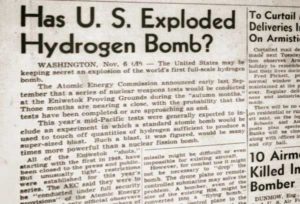 Nov 6: The Associated Press reports: “The United States may be keeping secret an explosion of the world’s first full-scale hydrogen bomb.” Noting that the Atomic Energy Commission had announced that a series of nuclear tests would take place at Eniwetok Atoll during the “autumn months,” the A.P. says that security surrounding the latest tests have been unusually tight. “Although announcements have been made after previous Eniwetok tests, some in only terse forms and others in more detail, this may not be done in the current series. One source explained that the public information and security rules are set up on the basis of each series and that there could be no certainty any announcement would be forthcoming this time. A full-scale test of a hydrogen weapon obviously might be the reason for the high degree of security imposed on the fall series.”
Nov 6: The Associated Press reports: “The United States may be keeping secret an explosion of the world’s first full-scale hydrogen bomb.” Noting that the Atomic Energy Commission had announced that a series of nuclear tests would take place at Eniwetok Atoll during the “autumn months,” the A.P. says that security surrounding the latest tests have been unusually tight. “Although announcements have been made after previous Eniwetok tests, some in only terse forms and others in more detail, this may not be done in the current series. One source explained that the public information and security rules are set up on the basis of each series and that there could be no certainty any announcement would be forthcoming this time. A full-scale test of a hydrogen weapon obviously might be the reason for the high degree of security imposed on the fall series.”
![]() Nov 8: Police in the diamond mining city of Kimberley, South Africa, fire on on a large group of black Africans protesting the nation’s apartheid laws. Demonstrators had blocked the whites-only entrance to the main post office and sat on whites-only benches at the Kimberley rail station. When police arrest protest leaders, a riot breaks out in what becomes known as the Mayibuye Uprising. Police fire on the crowd, killing thirteen and wounding 78 others. Some of those killed and wounded are innocent bystanders.
Nov 8: Police in the diamond mining city of Kimberley, South Africa, fire on on a large group of black Africans protesting the nation’s apartheid laws. Demonstrators had blocked the whites-only entrance to the main post office and sat on whites-only benches at the Kimberley rail station. When police arrest protest leaders, a riot breaks out in what becomes known as the Mayibuye Uprising. Police fire on the crowd, killing thirteen and wounding 78 others. Some of those killed and wounded are innocent bystanders.
![]()
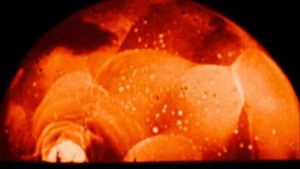 Nov 8: The Los Angeles Examiner publishes the “first eyewitness account of a hydrogen bomb explosion at Eniwetok.” Science editor Chris Clausen writes, “It is likely that the tremendous unparalleled force of the H-bomb — the world’s first — vaporized into gas and dust the atoll, a half mile wide and three miles long, on which the detonation took place.” The Examiner cites a letter furnished by a Los Angeles resident from a friend at the Atomic Energy Commission’s proving grounds at Eniwetok. The blast, according to the letter writer, “appeared as a huge orange ball, which grew larger and brighter until as if no dark glasses were there at all. … The ball of fire started to rise and slowly lose its intensity. We took off our glasses and saw water vapor suddenly form around the column. Then it rushed into the base of the column and up, ,clearing the air so that you could see countless tons of water rushing skyward. … All we could do was stand there and gasp in amazement and awe at the enormous size and force released before us. Typical comment form old timers: ‘Holy cow! That sure makes the A-bomb a runt.’ And so I saw our first H-bomb explode.” Military public information officers say that have no knowledge of any hydrogen bomb explosion in the Pacific area.
Nov 8: The Los Angeles Examiner publishes the “first eyewitness account of a hydrogen bomb explosion at Eniwetok.” Science editor Chris Clausen writes, “It is likely that the tremendous unparalleled force of the H-bomb — the world’s first — vaporized into gas and dust the atoll, a half mile wide and three miles long, on which the detonation took place.” The Examiner cites a letter furnished by a Los Angeles resident from a friend at the Atomic Energy Commission’s proving grounds at Eniwetok. The blast, according to the letter writer, “appeared as a huge orange ball, which grew larger and brighter until as if no dark glasses were there at all. … The ball of fire started to rise and slowly lose its intensity. We took off our glasses and saw water vapor suddenly form around the column. Then it rushed into the base of the column and up, ,clearing the air so that you could see countless tons of water rushing skyward. … All we could do was stand there and gasp in amazement and awe at the enormous size and force released before us. Typical comment form old timers: ‘Holy cow! That sure makes the A-bomb a runt.’ And so I saw our first H-bomb explode.” Military public information officers say that have no knowledge of any hydrogen bomb explosion in the Pacific area.
![]() Nov 9: The Atomic Energy Commission will neither confirm nor deny reports that a thermonuclear device was detonated recently at Eniwetok Atoll. But one Congressman more or less let the cat out of the bag. When asked for comment by a reporter, Rep. Carl T. Durham (D-NC), acting chairman of the Joint Committee on Atomic Energy, first replied, “Have they announced it?” Then he added, “I would hesitate to make any statement until it is officially announced.”
Nov 9: The Atomic Energy Commission will neither confirm nor deny reports that a thermonuclear device was detonated recently at Eniwetok Atoll. But one Congressman more or less let the cat out of the bag. When asked for comment by a reporter, Rep. Carl T. Durham (D-NC), acting chairman of the Joint Committee on Atomic Energy, first replied, “Have they announced it?” Then he added, “I would hesitate to make any statement until it is officially announced.”
![]()
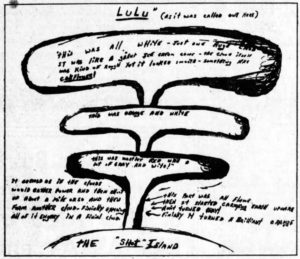 Nov 10: The Lima (Ohio) News publishes a letter from another eyewitness account of the thermonuclear detonation at Eniwetok Atoll. It contains many details similar to the letter published by the Los Angeles Examiner two days earlier. This one provides somewhat less details about the explosion itself, but he does include a drawing describing the cloud. The writer describes the island’s incineration after the blast. “About 15 minutes after shot time, the island on which the bomb had been set off started to burn and it turned a brilliant red. It burned for over six hours, gradually becoming smaller. Within six hours, an Island that once had palm trees and coconuts was now nothing. A mile-wide island had actually disappeared. I was watching through binoculars. At first I didn’t notice but when I saw a huge chink just seem to melt away, after that I watched closely.” As for the blast itself, the letter writer remarks, “It was even close to being beautiful.”
Nov 10: The Lima (Ohio) News publishes a letter from another eyewitness account of the thermonuclear detonation at Eniwetok Atoll. It contains many details similar to the letter published by the Los Angeles Examiner two days earlier. This one provides somewhat less details about the explosion itself, but he does include a drawing describing the cloud. The writer describes the island’s incineration after the blast. “About 15 minutes after shot time, the island on which the bomb had been set off started to burn and it turned a brilliant red. It burned for over six hours, gradually becoming smaller. Within six hours, an Island that once had palm trees and coconuts was now nothing. A mile-wide island had actually disappeared. I was watching through binoculars. At first I didn’t notice but when I saw a huge chink just seem to melt away, after that I watched closely.” As for the blast itself, the letter writer remarks, “It was even close to being beautiful.”
![]()
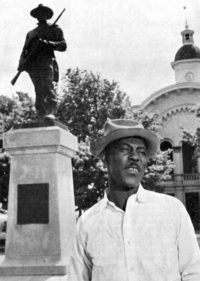 Nov 11: An all-white jury in Yanceyville, North Carolina, convicts Matt “Mack” Ingram, an African-American tobacco farmer, of assault by “leering” at Willa Jean Boswell, a seventeen-year-old white girl, from a distance of sixty feet. The jury of rural farmers take only 58 minutes to convict the father of nine under a law that provides that no actual physical contact is necessary to prove assault. This is the third trial for Ingram. The first, in the summer of 1951 shortly before his arrest, took place in Recorder’s Court, a kind of a justice of the peace, before an uneducated judge who sentenced Ingram to two years at hard labor on the county roads. That conviction was overturned on appeal because Recorder’s Courts have no jurisdictions to try such cases. Ingram’s second trial, with a jury consisting of eight whites and four blacks ended in a hung jury. Ingram is given a six months suspended sentence and probation for five years. His NAACP attorneys say they will appeal. The North Carolina Supreme Court will overturn his conviction in 1953.
Nov 11: An all-white jury in Yanceyville, North Carolina, convicts Matt “Mack” Ingram, an African-American tobacco farmer, of assault by “leering” at Willa Jean Boswell, a seventeen-year-old white girl, from a distance of sixty feet. The jury of rural farmers take only 58 minutes to convict the father of nine under a law that provides that no actual physical contact is necessary to prove assault. This is the third trial for Ingram. The first, in the summer of 1951 shortly before his arrest, took place in Recorder’s Court, a kind of a justice of the peace, before an uneducated judge who sentenced Ingram to two years at hard labor on the county roads. That conviction was overturned on appeal because Recorder’s Courts have no jurisdictions to try such cases. Ingram’s second trial, with a jury consisting of eight whites and four blacks ended in a hung jury. Ingram is given a six months suspended sentence and probation for five years. His NAACP attorneys say they will appeal. The North Carolina Supreme Court will overturn his conviction in 1953.
![]()
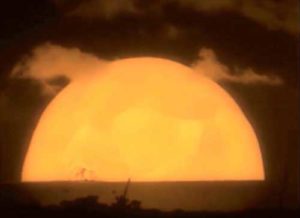 Nov 11: Other letters from eyewitnesses to the November 1 thermonuclear detonation at Eniwetok Atoll appear in newspapers across the country. The Deseret News-Telegram of Salt Lake City publishes a letter from a sailor sent to his mother. “Actually it was beautiful,” he wrote, “but when you think of the damage it can do, it’s ugly. I actually think people are getting too smart.” The Michigan City (Indiana) News-Dispatch publishes another letter from an Indiana sailor. He said his ship loaded the bomb in San Francisco and kept in a special compartment with the door welded shut and chains welded across it. After delivering the bomb, he wrote that the ship was cruising at about 35 miles from the island at the time of the blast. “I didn’t get to see the actual blast,” he wrote. “I was standing there with my eyes shut and my face pushed into my arms ,and still I saw the flash. It was just like someone putting a hot iron on your back for a split second.” The Atomic Energy Commission remains tight-lipped. “We will have absolutely no comment until the current series of atomic tests have concluded. Then we will make an announcement.”
Nov 11: Other letters from eyewitnesses to the November 1 thermonuclear detonation at Eniwetok Atoll appear in newspapers across the country. The Deseret News-Telegram of Salt Lake City publishes a letter from a sailor sent to his mother. “Actually it was beautiful,” he wrote, “but when you think of the damage it can do, it’s ugly. I actually think people are getting too smart.” The Michigan City (Indiana) News-Dispatch publishes another letter from an Indiana sailor. He said his ship loaded the bomb in San Francisco and kept in a special compartment with the door welded shut and chains welded across it. After delivering the bomb, he wrote that the ship was cruising at about 35 miles from the island at the time of the blast. “I didn’t get to see the actual blast,” he wrote. “I was standing there with my eyes shut and my face pushed into my arms ,and still I saw the flash. It was just like someone putting a hot iron on your back for a split second.” The Atomic Energy Commission remains tight-lipped. “We will have absolutely no comment until the current series of atomic tests have concluded. Then we will make an announcement.”
![]()
 Nov 13: Various newspapers publish four more eyewitness accounts of the still-unacknowledged hydrogen bomb detonation at Eniwetok Atoll. A Navy lieutenant wrote to his sister in Charlotte, North Carolina and described “one of the most beautiful yet most terrifying sights I have ever seen in my life. … a ball of brilliant white, red, and gold flame low on the horizon,, shooting up quickly and expanding.” A sailor from Decatur, Illinois, wrote that after the heat blast, “I opened my eyes and everyone around me reflected a bright shade of orange light. That lasted about five seconds.” When he was allowed to around to look at the blast,”it made the prettiest sight I have ever seen. … There was red in the sky two hours after the blast.” Another sailor wrote to his parents at Fort Dodge, Iowa, whose ship, the escort carrier USS Rendova, was thirty miles from ground zero. “If only you could have seen it you would swear the whole world was on fire. It was really something I’ll never forget.” A Knoxville sailor wrote his mother, “I know I never one to see another one, unless it is on peace terms.”
Nov 13: Various newspapers publish four more eyewitness accounts of the still-unacknowledged hydrogen bomb detonation at Eniwetok Atoll. A Navy lieutenant wrote to his sister in Charlotte, North Carolina and described “one of the most beautiful yet most terrifying sights I have ever seen in my life. … a ball of brilliant white, red, and gold flame low on the horizon,, shooting up quickly and expanding.” A sailor from Decatur, Illinois, wrote that after the heat blast, “I opened my eyes and everyone around me reflected a bright shade of orange light. That lasted about five seconds.” When he was allowed to around to look at the blast,”it made the prettiest sight I have ever seen. … There was red in the sky two hours after the blast.” Another sailor wrote to his parents at Fort Dodge, Iowa, whose ship, the escort carrier USS Rendova, was thirty miles from ground zero. “If only you could have seen it you would swear the whole world was on fire. It was really something I’ll never forget.” A Knoxville sailor wrote his mother, “I know I never one to see another one, unless it is on peace terms.”
![]()
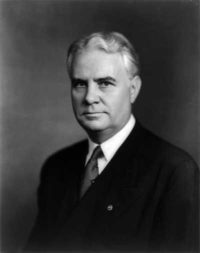 Nov 13: Sen. John Bricker (R-OH), a member of the joint Senate House Atomic Committee, tells a reporter in Columbus that he is concerned about the secrecy — or lack of it — surrounding the officially unacknowledged reports of a hydrogen bomb detonation on November 1. “I will want any explanation of whether the tight security secrecy was necessary — and, if so, whether these anonymous reported eye-witness accounts indicate that security was not properly enforced. All these published accounts may indicate that someone slipped a cog on enforcing security regulations.”
Nov 13: Sen. John Bricker (R-OH), a member of the joint Senate House Atomic Committee, tells a reporter in Columbus that he is concerned about the secrecy — or lack of it — surrounding the officially unacknowledged reports of a hydrogen bomb detonation on November 1. “I will want any explanation of whether the tight security secrecy was necessary — and, if so, whether these anonymous reported eye-witness accounts indicate that security was not properly enforced. All these published accounts may indicate that someone slipped a cog on enforcing security regulations.”
![]() Nov 16: The Atomic Energy Commission announces late on Sunday that “experiments contributing” to H-bomb research have been completed. “Scientific executives for the test have expressed satisfaction with the results,” the statement says. “The leaders and members of the military and civilian components of the task force have accomplished a remarkable feat of precision.” The statement does not explicitly say that a hydrogen bomb has been detonated. In a separate statement, the AEC says that it is investigating the letters that have been showing up in the nation’s newspapers over the past week as possible security violations.
Nov 16: The Atomic Energy Commission announces late on Sunday that “experiments contributing” to H-bomb research have been completed. “Scientific executives for the test have expressed satisfaction with the results,” the statement says. “The leaders and members of the military and civilian components of the task force have accomplished a remarkable feat of precision.” The statement does not explicitly say that a hydrogen bomb has been detonated. In a separate statement, the AEC says that it is investigating the letters that have been showing up in the nation’s newspapers over the past week as possible security violations.
![]() Nov 25: The musical film Hans Christian Anderson premieres in New York City. It stars Dany Kaye, Farley Granger, and Zizi Jeanmarie.
Nov 25: The musical film Hans Christian Anderson premieres in New York City. It stars Dany Kaye, Farley Granger, and Zizi Jeanmarie.
![]()
 Nov 29: Sen. Pat McCarran (D-NV), a strong supporter of Sen. Joseph McCarthy’s (R-WI) Red and Lavender Scares, says that “propagandists for disloyalty are being allowed to teach in colleges and lesser schools throughout the United States.” The chairman of the Senate Internal Security subcommittee makes these comments while releasing a 412-page subcommittee report containing transcripts of hearings held in New York. The report claims that as many as 1,500 Communists hold teaching positions in private and public schools around the country. “Though this number many not seem large in comparison with the million teachers employed in the schools,” says McCarran, “the nature of Communist party operations make them as dangerous as a lighted match in a powder magazine.” The New York City Board of Education has already suspended eight teachers, and other school boards and colleges around the country will launch purges over the next few years.
Nov 29: Sen. Pat McCarran (D-NV), a strong supporter of Sen. Joseph McCarthy’s (R-WI) Red and Lavender Scares, says that “propagandists for disloyalty are being allowed to teach in colleges and lesser schools throughout the United States.” The chairman of the Senate Internal Security subcommittee makes these comments while releasing a 412-page subcommittee report containing transcripts of hearings held in New York. The report claims that as many as 1,500 Communists hold teaching positions in private and public schools around the country. “Though this number many not seem large in comparison with the million teachers employed in the schools,” says McCarran, “the nature of Communist party operations make them as dangerous as a lighted match in a powder magazine.” The New York City Board of Education has already suspended eight teachers, and other school boards and colleges around the country will launch purges over the next few years.
![[Emphasis Mine]](http://jimburroway.com/wp-content/uploads/2018/01/Gay_Rights_demonstration_NYC_1976.jpg)
